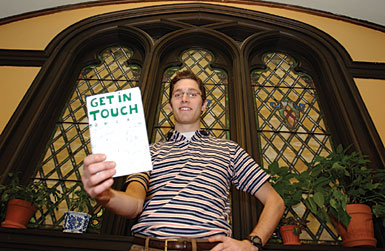Vital Signs
New health guide for low-income patients was student handiwork
It's not often that a lowly medical student is feted at a community celebration. But in September, when the staff and patients of the Good Neighbor Health Clinic in White River Junction, Vt., threw a party to mark the publication of a new community health guide, the guest of honor was DMS student Stanley Weinberger, the driving force behind the project.
Idea: In 2001, Weinberger, then a second-year student, received a Schweitzer Fellowship to develop a directory for low-income residents of the Vermont and New Hampshire communities near Dartmouth. It was the kind of elegantly simple idea that made people wonder why no one had thought of it before.

|
|
Stan Weinberger shows off the popular community health guide he put together. |
As a volunteer at the Good Neighbor Clinic, which provides primary care to un- and underinsured patients, Weinberger had realized that the clinic's staff were asked a lot of questions not directly related to medicine but vital to patients' overall health. They were looking for advice on everything from domestic violence to affordable housing.
Working with Good Neighbor director Karen Woodbury and nurse case manager Ceil Furlong, Weinberger came up with the idea of compiling a comprehensive directory of services that could be put right in patients' hands. "Giving patients the ability to go seek care is a relatively easy way to affect their health," Weinberger says. He titled the project "Get in TOUCH" (The Original Upper Valley Community Health Guide).
Two years later, "Get in TOUCH" appeared as a handsome, 100-page publication that includes information to help patients take charge of their own health as well as find a variety of medical and social services. It explains the basics of nutrition and meal-planning, for instance, as well as how to apply for food assistance programs.
Input: What makes the guide so useful, Furlong says, is that Weinberger sought lots of input. A focus group of eight patients or former patients advised him during the year it took to do the research and writing. "Without them, we wouldn't have thought of half the things we included," Furlong notes.
"They were a very important part of this project," Weinberger agrees. "We were lucky to have such a knowledgeable, proactive group. And they wanted to know about everything—not just how to find a dentist who accepts Medicaid, but things like transportation, jobs, spirituality." As a result, the guide grew well beyond Weinberger's original vision, but he believes it was essential to listen to the people who'd actually be using it.
"Doctors have a very patientspecific focus, rather than seeing the whole community," he says. "They tend to concentrate on a particular person's medical problem, but it's important to think about improving the health care of the entire community." In fact, Weinberger is taking this year off from his M.D. studies to earn an M.S. in the evaluative clinical sciences. "I'll always be interested in pediatrics," he adds, "but I'd like to stay involved in community health, too, especially access to health care."
"Get in TOUCH" is flying off the shelves, says Furlong. Within three months, only 500 copies remained from the first printing of 2,600, and plans were under way for a second printing. (For a PDF of the guide, go to www.dartmouth.edu/dms and do a search for "TOUCH.")
The guide's success, Furlong adds, is a direct result of "how much Stan valued what the patient focus group brought to the project and how well he listened to them. He's going to be a fantastic doctor."
Catherine Tudish
